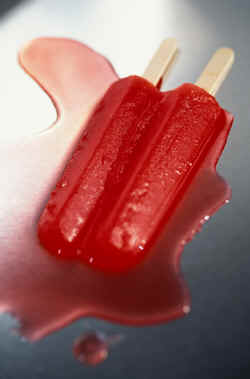Superconductor Unfazed by Its Transition

To the physicist, phase transitions are everywhere: Water becomes ice; a nonmagnetic material becomes magnetic; a normal metal becomes superconducting–all from a drop in temperature. Phase transitions are categorized as either first or second order, depending on the abruptness of the changes that occur at the transition. Higher order transitions don’t seem to exist in nature. But the 31 May PRL contains a description of a fourth order phase transition observed in an unusual superconductor. The authors base the claim on their magnetic measurements over wide ranges in temperature and magnetic field and suggest that many high order transitions may exist that have not yet been recognized.
When ice melts, it uses energy to break up the crystal structure, but many phase transitions occur without the need for any additional energy, or latent heat, to reorganize the structure. An example of one of these smoother, second order transitions is the change in magnetic materials when they are heated above a critical temperature: The atomic magnetic moments become randomly oriented rather than aligning in a single direction. Although the free energy is constant, other properties change suddenly at the transition temperature of a ferromagnet, such as the specific heat–the amount of heat required to change the material’s temperature by one degree. According to one classification scheme, in third and higher order transitions the specific heat does not change at the transition temperature, but even more abstract quantities experience a sudden jump. There is no physical reason why higher order transitions could not exist.
Roy Goodrich of Louisiana State University in Baton Rouge and Donavan Hall, now of the National High Magnetic Field Laboratory in Tallahassee, studied the magnetic properties of the quirky superconductor which becomes superconducting below 32 K. Although similar to the better known high temperature superconductors, it has different magnetic properties in the normal state and has a more symmetrical crystal structure. Goodrich and Hall determined the strength of magnetic fields needed to distort the superconductivity and found the three so-called critical magnetic fields of the material. They found temperature dependences of these fields that were different from any other superconductor.
Goodrich and Hall collaborated with Pradeep Kumar of the University of Florida in Gainesville, who helped explain the strange results as a fourth order phase transition. “It’s a transition that goes like a whimper as opposed to a bang,” says Kumar, because “its thermodynamic properties seem not to change” at the transition, even though the electrical resistance goes to zero. The team developed a theory for this unique transition and show in their PRL paper that the magnetic field results are consistent with it. Other researchers had failed to find the jump in specific heat normally experienced by superconductors at the transition temperature, a result also consistent with a higher order transition.
“If it’s true I think it’s very interesting and probably very important,” says Brian Maple of the University of California at San Diego. Although he admits to a bit of skepticism about the claim, he says that a better understanding of this material could shed light on the related high-temperature superconductors. Kumar seems to relish the unusual nature of the claim of a higher order transition. “The thinking is all a bit off the box,” he says.
More Information
Later authors dispute these results in Phys. Rev. Lett. 83, 4622 (1999).


